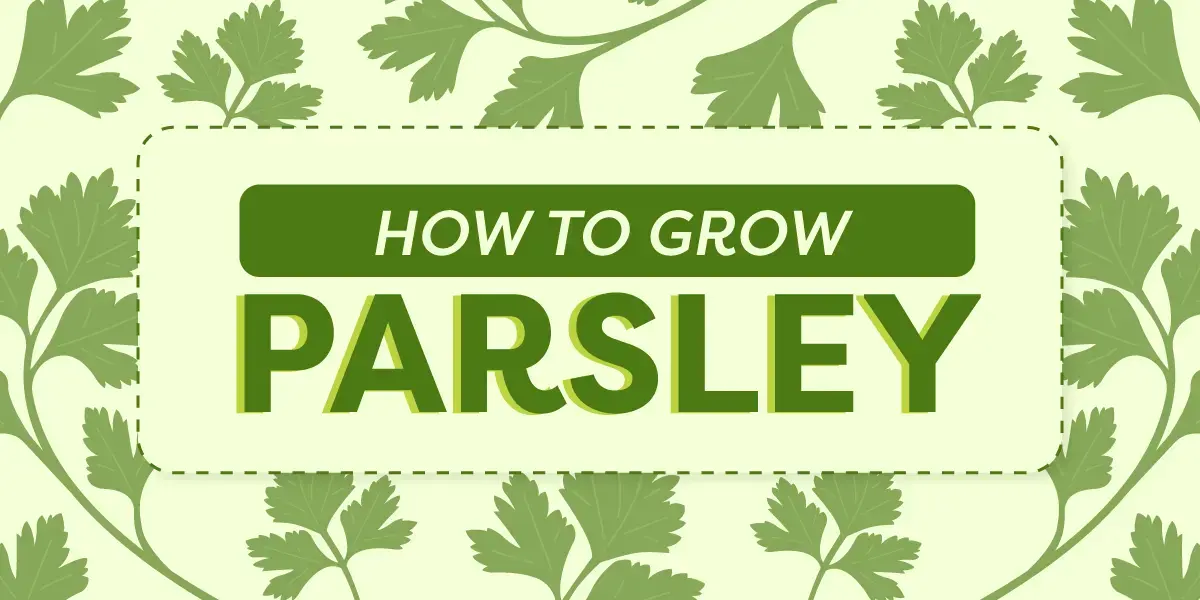Parsley was first cultivated over 2,000 years ago in the central Mediterranean region, including parts of modern Italy, Algeria, and Tunisia.
Today, every self-respecting Mediterranean salad includes parsley, and the plant’s exotic leaves make it a garnish par excellence.
The plant is remarkably easy to grow indoors or out. Once you’ve experienced crisp, fresh parsley from the garden, you’ll never be satisfied with the limp product sold in stores.
Why Grow Parsley?
Parsley is more than a pretty plant. It’s a nutritional powerhouse packed with vitamins, minerals, and antioxidants.
The ancient Romans revered it for its culinary and medicinal uses. They adorned their heads with parsley wreaths during feasts, believing it would prevent intoxication (it didn’t).
Its digestive and anti-inflammatory properties made it a common remedy for stomach and joint ailments.
Parsley was a mainstay in sauces and broths, its bright flavor complementing the rich Roman cuisine. To the Romans, parsley was more than an herb — it was THE herb.
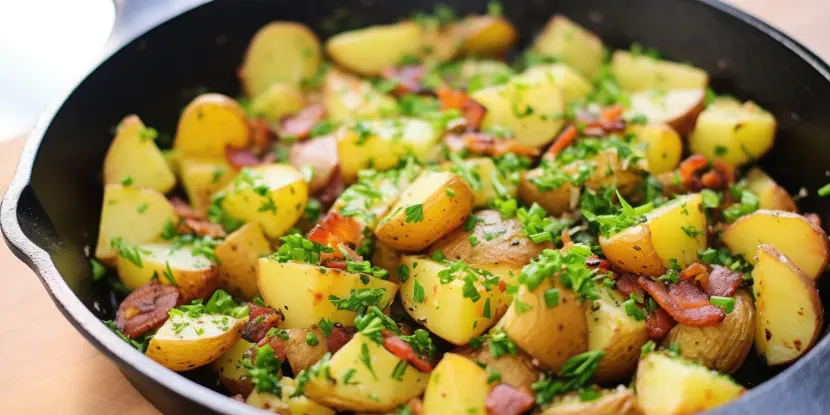
Parsley garnishing a fried potato dish.
Growing Parsley Indoors vs. Outdoors
Indoor Gardening
- Year-round access to fresh parsley
- Best for cold climates or homes without outdoor space
- Allows for easier control over the plant’s environment, including temperature, light, and humidity
Outdoor Gardening
- Produces larger yields due to space for root growth
- Greater access to natural light
- Exposes plants to natural pollinators, enhancing plant health and productivity
- Parsley helps control pests and diseases in the entire garden
Southern California’s mild climate allows for rear-round parley cultivation outdoors. While the plant may benefit from shade during the hottest months to prevent bolting, it does well in sunny or partly shaded areas.
In colder climates, parsley is a biennial plant that produces for two years before going to seed. It thrives in cooler temperatures and can tolerate light frost.
Choosing the Right Variety
There are two main varieties of parsley, each with its distinct uses.
- Flat-leaf or Italian parsley has a robust flavor and is preferred in culinary applications. Its leaves are smoother, and it’s more tolerant of hot weather than its curly-leaved cousin. Its flavor holds up better when heated, making it ideal for soups, stews, and sauces.
- Curly-leaf parsley has a milder taste and is often used as a garnish due to its decorative, ruffled leaves. It’s not just for show, though; curly parsley can also be used in cooking, albeit with subtler flavor contributions. Its texture and dark green color add a crisp finish to dishes and salads.
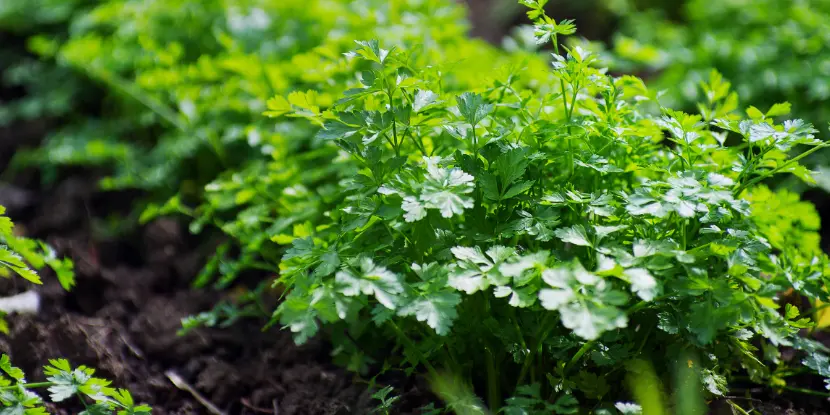
Italian parsley growing in the garden.
Root System
Parsley has a long, central taproot with smaller roots branching from it. This system lets the plant reach water and nutrients deeper within the soil, contributing to its resilience and low maintenance needs once established.
Pots for container cultivation should be at least 8 to 12 inches deep. When planted outdoors, parsley should be spaced 6 to 8 inches apart to provide room for root expansion.
Planting Parsley Seeds
- Preparation: Soak the parsley seeds overnight in warm water to soften the outer shell and encourage germination.
- Sowing Depth: Plant seeds a quarter inch deep in well-draining soil. Parsley can be sown in pots for indoor gardens or directly in the garden bed outdoors.
- Spacing: Space the seeds or seedlings about 6 to 8 inches apart to give each plant enough room to grow.
- Light Conditions: Ensure the plants receive at least six hours of sunlight daily. Indoors, a south or west-facing window or artificial grow lights can provide sufficient light.
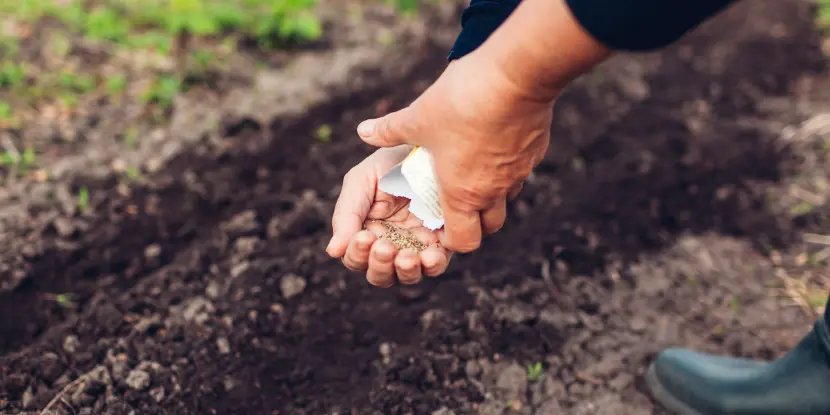
Planting parsley seeds in the garden.
How to Grow Parsley Indoors
- Fill the pot with potting soil, leaving about an inch of space at the top.
- Plant 3-4 parsley seeds in a group, about 1/4 inch deep into the soil.
- Water lightly and place in a warm, sunny spot.
- Once the seeds have germinated, thin out plants to the strongest seedling in each group.
- Water regularly and fertilize every 4-6 weeks with a balanced fertilizer.
- Harvest parsley once the plant has reached 8-10 inches tall.
How to Grow Parsley Outdoors
- Choose a sunny or partly shaded spot with well-draining soil.
- If using a container, fill it with potting soil, leaving about an inch of space at the top.
- Plant 3-4 parsley seeds in a group, about 1/4 inch deep into the soil.
- Water lightly and place in an area with good air circulation.
- Once the seeds have germinated, thin plants out to the strongest seedling in each group, leaving at least 6 inches between plants.
- Water regularly and fertilize every two weeks with a balanced fertilizer.
- Harvest parsley once the plant has reached 8–10 inches tall.

A close-up of curly parsley leaves.
Tips for Successful Growth
- Parsley thrives in slightly acidic soil with a pH of 6.0-7.0.
- Keep the soil consistently moist but not soggy.
- Fertilize regularly to promote healthy growth and flavor.
- Trim off any flowers that appear, as they can cause the plant to stop producing new foliage.
- Harvest parsley by cutting off the outer stems from the base of the plant, allowing the inner leaves to continue growing.
- Rotate plants every few weeks to ensure even growth and prevent pests and diseases.
- If growing indoors, consider using a grow light during winter when natural sunlight is limited.
Common Pests & Diseases Affecting Parsley
Even the hearty parsley plant has its share of garden pests and diseases. These include:
- Aphids: These tiny pests can drain the sap from parsley leaves, weakening the plants. Spray the plants with a jet of water to knock aphids off. For more persistent problems, apply neem oil or insecticidal soap.
- Carrot Fly: Parsley is a close relative of carrots. Carrot fly larvae can damage the roots, impairing growth. Use floating row covers to protect the plants, or plant parsley alongside garlic and chives to repel the carrot fly naturally.
- Slugs and Snails: These chew on the leaves, especially in wet conditions. Spread diatomaceous earth around the base of your plants, or set up beer traps nearby to lure and trap slugs and snails
- Powdery Mildew: This occurs as a white powdery deposit on the leaf surface and can lead to leaf drop. To treat infected plants, ensure good air circulation around them and use a baking soda spray mixture.
- Downy Mildew: Appears as yellow patches on the upper leaf surface and fluffy white growth on the underside. Remove and destroy affected foliage. Avoid overhead watering to reduce humidity, and apply a copper-based fungicide as a preventive measure.
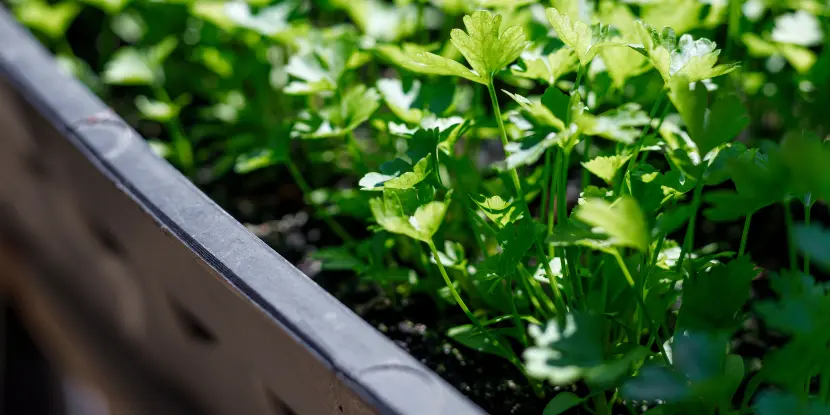
Parsley growing in a large container.
Companion Plants for Parsley
Companion planting involves placing other plant species near each other in the garden to enhance growth, deter pests, and encourage pollination. For parsley, beneficial companions include:
- Tomatoes
- Peppers
- Corn
- Carrots
- Chives and garlic
- Asparagus
- Beans
- Lettuce and spinach
- Roses (parsley attracts hoverflies, which feed on aphids that often target roses)
FAQs: How to Grow Parsley
Q: Can I grow parsley from cuttings?
While parsley can be propagated from cuttings, growing from seeds is generally easier.
Q: What pests are attracted to parsley?
Common pests include aphids, caterpillars, and spider mites. Use natural predators or insecticidal soap to control infestations.
Q: Can I grow parsley indoors year-round?
With proper care and sunlight, parsley can be grown indoors throughout the year.
Q: How often should I water my parsley plants?
Watering needs vary by temperature and soil type, but generally, parsley should be watered once the soil starts to dry. This usually means watering once every 1-2 days during hot, dry periods and reducing frequency during cooler, wetter times.
Q: How long does parsley take to germinate?
Parsley seeds can take 14-21 days to germinate. Keep the soil consistently moist and ensure adequate warmth to encourage faster germination.
Q: Is it necessary to use fertilizer for parsley, and if so, which kind?
A balanced, all-purpose liquid fertilizer every 4-6 weeks during the growing season can promote fuller, healthier parsley plants. Avoid over-fertilizing, as this can lead to excess foliage growth at the expense of flavor.
Q: Can parsley be grown alongside mint?
It’s best to plant parsley and mint separately. Mint is an aggressive grower and can easily overpower parsley plants.
Q: How do I know when my parsley is ready to harvest?
When parsley leaves look full and vibrant, and the stems have three segments, the plant is usually mature enough for harvesting. This typically occurs within 70-90 days from planting.
Q: Can I save seeds from my parsley plants for next year?
Yes. At the end of the season, allow a few plants to flower and set seed. Once the seed heads turn brown, collect them, dry them completely, and store them in a cool, dry place.
Q: How can I tell if my parsley plant is overwatered?
Signs of overwatering include yellowing leaves, wilted or soft stems, and mold or algae growth on the soil surface. If you suspect overwatering, allow the soil to dry out more between watering sessions.
Q: What should I do with my outdoor parsley plants in winter?
In areas with mild winters, parsley may survive outdoors with some mulch for protection. Consider bringing potted parsley indoors or covering it with a cold frame or garden fleece in colder climates.

